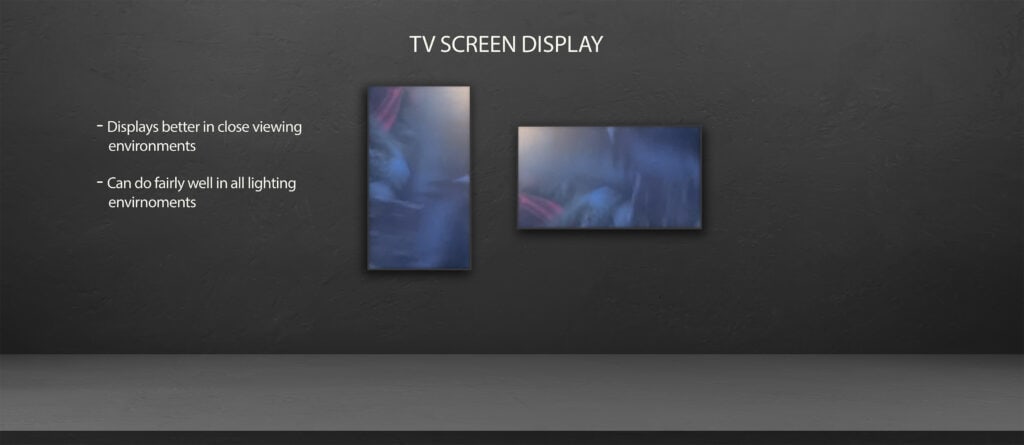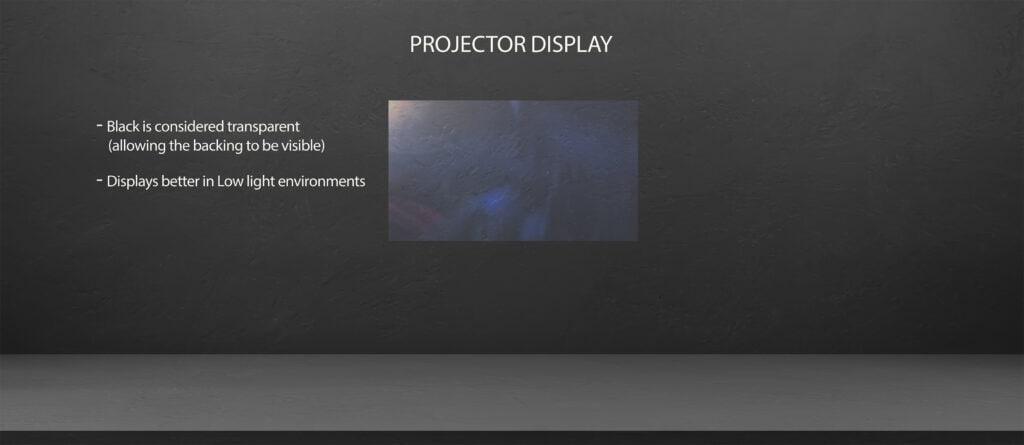Insert Video*
Understanding Contrast Ratio: Projectors vs. TVs vs. LEDs
In the vibrant world of visual technology, the term ‘contrast ratio’ defines the cornerstone of image quality, yet it remains a concept that many find elusive. This measure, indicating the range between the darkest and brightest values a display can produce, is fundamental in determining the vividness and depth of the picture presented. Understanding the contrast ratio is crucial, not only for tech enthusiasts but for anyone looking to make an informed decision when selecting among the myriad options of projectors, TVs, and LEDs. Each of these display technologies boasts its own ideal contrast ratio, influencing their efficacy in various environments and uses.
This article aims to demystify the concept of contrast ratio, shedding light on what is indicated by the contrast ratio of a monitor, and exploring the differences in the dynamic contrast ratios among projectors, TVs, and LEDs. By comparing these technologies, we’ll underscore how the contrast ratio meaning shifts in context, and how these differences make certain devices more suitable for specific applications. Moreover, we’ll delve into the potential impacts a high contrast ratio can have on the lifespan of these devices, offering insight into how utilizing displays with optimal contrast ratios can enhance your viewing experience. Through this exploration, we aim to equip you with the knowledge to discern which device best suits your needs, ensuring your investment delivers the quality and longevity you expect.
Understanding Contrast Ratio: The Basics
Definition of Contrast Ratio
Contrast ratio is defined as the measurement of the difference between the brightest white and the darkest black that a display can produce. A typical example is a contrast ratio of 1,000:1, where the brightest white is 1,000 times brighter than the darkest black. This measurement is crucial as it affects the depth and vividness of the display’s image quality.
How Contrast Ratio is Measured
There are two primary methods to measure contrast ratio: Static Contrast and Dynamic Contrast. Static Contrast, also known as native contrast, compares the brightest and darkest shades a display can produce simultaneously, providing a more accurate representation of a display’s capabilities 4. Dynamic Contrast, however, measures the potential range of contrast using the lightest and darkest scenes, although this method can often present misleading values due to manufacturer manipulations 45. ANSI contrast, using a checkerboard pattern, and the full on/full off method are other common measurement techniques that aim to provide a realistic depiction of a display’s contrast capabilities 5789.
Importance of Contrast Ratio
A higher contrast ratio is generally better, enhancing the display’s ability to produce deep blacks and vibrant colors, leading to a more lifelike image 456101112. It plays a vital role in various applications by improving visibility, readability, and overall image quality, especially in environments with varying lighting conditions 12. High contrast ratios are particularly essential for HDR content, where a wide range of colors and luminance levels are displayed 12.
Contrast Ratio in Projectors vs. TVs vs. LEDs
Contrast Ratio in Projectors
Projectors, especially DLP and LCD types, are known for their high contrast ratios, which are crucial for producing deep blacks and bright whites. This capability enhances the visual experience in various settings such as home theaters, classrooms, and business presentations, making the content more engaging and easier to view 2021. In darker environments, a higher contrast ratio allows for a more detailed and vibrant image, which is particularly important for watching movies or playing video games 20.
Contrast Ratio in TVs
TVs generally offer better contrast ratios compared to projectors, with technologies like OLED and QLED leading the way by providing exceptional depth and color vibrancy. This superior contrast ratio results in images that are rich in detail and offer a more lifelike viewing experience. High-quality TVs can achieve this by utilizing advanced panel technology that allows for deeper blacks and more pronounced contrast between different elements of the image 14.
Contrast Ratio in LEDs
Contrast in LED displays is a crucial factor, especially for outdoor displays and medium to large indoor displays. High contrast ratios are essential in these settings to ensure that content remains visible and impactful, regardless of ambient lighting conditions. Outdoor displays, such as digital billboards and signage, benefit immensely from high contrast ratios, which allow them to deliver clear and vibrant images even under direct sunlight. Similarly, large indoor displays, often used in venues like shopping malls, airports, and conference centers, rely on superior contrast ratios to captivate audiences with sharp, detailed visuals. Technologies like full-array local dimming and direct backlighting enable these LED displays to achieve exceptional contrast, enhancing the depth and vividness of the content. By prioritizing contrast ratio, these displays can provide a more engaging and effective visual experience, making them indispensable tools for advertising, information dissemination, and entertainment.
Potentials and Limitations
Advantages and Disadvantages of Projectors
Projectors offer a high contrast ratio which is crucial for vivid and detailed image quality, especially in controlled, dark environments 31. They enhance visual impact, making content more engaging and legible 31. However, projectors can suffer from lower contrast sensitivity and visual acuity in bright conditions, and slight increases in contrast ratio may not be noticeably impactful 31.
Projectors
Specification | Details |
Contrast Ratio | 3,000 |
Lifespan | 20,000 hrs |
Runtime per 24hr | 8-12 hrs |
Brightness (out of 100) | 60 |
Advantages and Disadvantages of TVs
TVs, particularly those using OLED technology, provide excellent contrast ratios, producing deeper blacks and enhancing overall picture quality 3435. High contrast ratios in TVs improve the viewing experience in dark settings 34. On the downside, TVs with IPS panels may exhibit poorer contrast ratios, affecting the depth of blacks and overall image quality 35.
TV Screens
Specification | Details |
| Contrast Ratio | 4,000:1 |
| Lifespan | 30,000 hrs |
| Runtime per 24hr | 16-18 hrs |
| Brightness (out of 100) | 80 |
Advantages and Disadvantages of LEDs
LEDs are highly energy-efficient and have a long lifespan, making them cost-effective and environmentally friendly 373839. They offer versatility in size and design, suitable for various applications from residential lighting to automotive and street lighting 38. However, LEDs can emit harmful blue light and are sensitive to voltage spikes, which may lead to potential safety issues 37. Additionally, LEDs are generally more expensive upfront compared to traditional lighting options 37.
LED Screens
Specification | Details |
Contrast Ratio | 3000:1 ~ 14000:1 |
Lifespan | 50,000 hrs |
Runtime per 24hr | 24 hrs |
Brightness (out of 100) | 100 |
Conclusion
In dissecting the complexities of contrast ratio across projectors, TVs, and LEDs, we unveil the intricate ways in which these devices capitalize on their unique capabilities to enhance viewing experiences. Projectors, with their expansive display size, thrive in controlled lighting, making them prime for immersive cinematic and gaming experiences. TVs, on the other hand, leverage technologies like OLED and QLED to deliver outstanding contrast ratios and image quality, perfect for home entertainment where detail and color depth are paramount. LEDs excel in versatility and energy efficiency, their high contrast ratios making them ideal for a range of applications, from professional graphic design in stores as a feature to The perfect statement for an outdoor sign. The key takeaway is that each technology possesses an ideal contrast ratio that not only suits different use cases but also impacts the device’s lifespan, highlighting the importance of choosing the right option based on specific needs and using it correctly.
Technical Specifications Comparison Table
| Feature | LED Screens | TV Screens | Projectors |
| Contrast Ratio | 3000:1 ~ 14000:1 | 4000:1 | 3000:1 |
| Lifespan | 50,000 hrs | 30,000 hrs | 20,000 hrs |
| Runtime per 24hr | 24 hrs | 16-18 hrs | 8-12 hrs |
| Brightness (out of 100) | 100 | 80 | 60 |
| Energy Efficiency | High | Medium | Low |
| Maintenance Costs | Low | Medium | High |
| Best Value for Money | 1st | 2nd | 3rd |
*following vast growth in technology, all details are subject to change, contact digital specialists, PDT to speak to your current technology needs.
Reinforcing this understanding helps in making informed decisions tailored to optimize your Customers visual experience and device longevity. It becomes clear that the quest for the perfect display technology hinges on balancing contrast ratios with intended use, ensuring that the selected device enhances the content it displays. Whether it’s embracing the depth of blacks to make a Logo pop, the vivid colors of a promo ad in a campaign, or the crisp details of text or an abstract 3D creative, understanding the strengths and limitations of each display type is crucial. To aid in navigating this choice and identifying the best display technology for your needs, consider reaching out to the experts. Contact PDT – Public Display Technologies, Specialists in Display Technologies, for professional advice tailored to your requirements.
FAQs
1. What constitutes a good contrast ratio for home theater projectors?
A contrast ratio of 3,000:1 is generally considered very good for home theater projectors. 2. What is an ideal contrast ratio for TVs?
Contrast ratios in TVs vary significantly, but many newer TVs have contrast ratios exceeding 3,000:1. 3. How do LED TVs and projectors differ in terms of technology and image quality?
Both LED TVs and projectors utilize LED technology. Projectors require frequent adjustments for clarity and periodic bulb replacements to maintain image quality. In contrast, LED TVs provide superior image quality and are more cost-effective over time. 4. Are projectors a better option than TVs in some cases?
Yes, projectors can provide a superior viewing experience and offer better value in some cases. They typically offer a much larger screen size at a lower cost per inch compared to TVs, However it depends on the experience you are hoping to have. 5. Is there a rule of thumb to go by?
No, In this forever evolving climate of technology, its hard to forecast trends and details that are almost always changing, However, one thing that is consistent is that PDT is always at the forefront of technology. contact us to assist with your needs as we continue to make technology useful.


